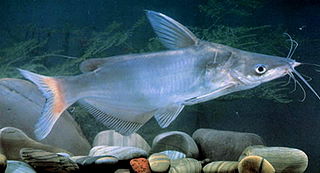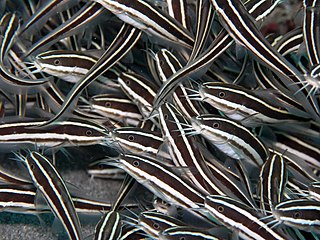
The Aspredinidae are a small South American family of catfishes also known as the banjo catfishes, with about 43 species.

Rineloricaria is a genus of freshwater tropical catfish belonging to the family Loricariidae. They are commonly called whiptail catfish because of the long filament that grows out of the tip of the caudal fin that is characteristic of the genus. With the exception of R. altipinnis from Panama, they are native to the rivers of northern and central South America. Some species are regularly seen in the aquarium trade.

Cranoglanis is the only genus of armorhead catfishes.

Leiocassis is a genus of bagrid catfishes found mostly in Southeast Asia with some species occurring in China.

Pseudobagrus is a genus of bagrid catfishes that inhabit streams and rivers throughout East Asia. About half of these species occur in China.
Pseudomystus is a genus of catfishes of the family Bagridae.

Diplomystidae, the velvet catfishes, are a family of primitive catfishes endemic to freshwater habitats in Argentina and Chile in southern South America. It currently contains six species in two genera.
Gogo is a small genus of catfishes of the family Anchariidae. It includes four species.

Amblyceps is a genus of fish in the family Amblycipitidae. The genera Amblyceps and Liobagrus are sister group pair that is, in turn, sister to Xiurenbagrus. These species are easily distinguished by the presence of pinnate processes along with the median caudal-fin rays, a prominent cup-like skin flap above the base of the pectoral spine, and the adipose fin largely separate from the caudal fin. In most species the caudal fin is deeply forked; A. apangi and A. murraystuarti differ in having their caudal fin truncate. Amblyceps species may reach about 100 millimetres (3.94 in) SL.
Exostoma is a genus of sisorid catfishes native to Asia. These species are distributed in the Brahmaputra drainage of north-eastern India, and east and south to the Salween drainages in Burma. E. berdmorei is found in the Sittang and Salween drainages in Burma. E. labiatum is known from the Brahmaputra drainage in north-eastern India, but has also been recorded in the Salween drainage in Burma, the Ayeyarwady drainage in China, and the Brahmaputra drainage in Tibet and Burma. E. stuarti is from the Ayeyarwady River of Burma and India; however, it has not been collected since its original discovery. E. labiatum is found in mountain rapids.

Plotosus is a genus of eeltail catfishes native to the Indian Ocean, the western Pacific Ocean and New Guinea.

Belonoglanis is a genus of catfishes of the family Amphiliidae. Both species occur in the Congo River basin.

The bayad, is a species of bagrid catfish from Africa.
The Somalia catfish is a species of catfish in the family Bagridae. The Somalia catfish is native to the Jubba River in Somalia.

Chrysichthys is a genus of claroteid catfishes native to Africa. Two fossil species are known. Chrysichthys macrotis, Van Neer, 1994, is known from the Miocene-Pliocene of the Albertine Rift in Uganda and Chrysichthys mahengeensis, Murray & Budney, 2003, is known from the Eocene of Mahenge, Tanzania.

Phractura is a genus of loach catfishes that occur in Africa.
Tetracamphilius is a genus of catfishes of the family Amphiliidae. It includes four species.

Heterobranchus is a genus of airbreathing catfishes native to Africa. However, H. palaeindicus, an extinct species of the genus, was discovered in the Siwalik Hills, India, dating to the Lower Pliocene.
Alfredo Borelli was a French-born Italian zoologist, who worked mainly in Turin but who, early in his natural history career, conducted field work in South America.
Pterygoplichthys ambrosettii, sometimes known as the snow king pleco, is a species of armored catfish native to south-central South America.













